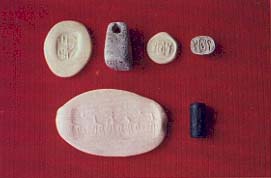Image Details

George L. Kelm
A scarab (upper right), an Egyptian seal in the form of a beetle, turned up in the debris of the large Canaanite building destroyed in about 1400 B.C. Probably the property of the building’s resident, who may have been the local governor, the seal bears the cartouche—a hieroglyphic name enclosed in an oval—of Pharaoh Amenophis III (1417–1379 B.C.), as seen in the impression (second from right).
Spindly-legged animals parade across the impression (lower center) produced by rolling the cylinder seal (beside the impression) in moist clay. The lower row, left to right, consists of a gazelle, the mythological gryphon and a bull; above them appear an eagle and a crouching lion. The images begin to repeat on the far right, where the seal started its second rotation. Found in the 15th-century B.C. Canaanite building, the seal’s artistic style is evidence of its local Canaanite origin.
